|
Photos on this page are viewable size, please be patient while
they load. Thank you.
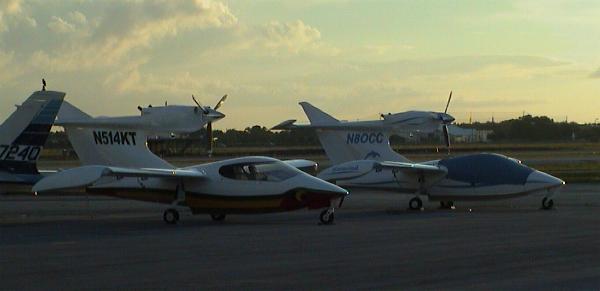
Sunrise at the 2003 Seawind Fly-in, September 27, 2003.
ISPA Members Larry Sapp and Keith Walljasper's Seawinds.
Dolphin Aviation, Sarasota, Florida.

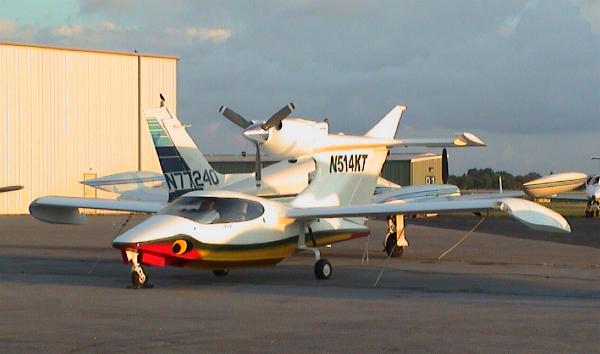
Larry Sapp's Seawind (above)
Photos do not even come close to showing the actual beauty of this work of art.
Up close, this paint job (done by Chris and those at Bowes Aviation) is simply
stunning.
Just one of Larry's life long hobbies has been carving his own fishing lures.
This is his largest to date (he said he has "omitted the tail hook").

2003 Attendees: Fred Lohr, Keith Walljasper, John
Parks, Mike Bowes, Dick Wolf, Tom Saccio, Ed Lynch, Larry Sapp, Ron
Greely, Brent Carlson, and Bowes Aviation master craftsmen Chris Dougherty and
Larry Januszewski,
Several of us brought friends and family members (names may be provided later, I failed
to get a list, was overwhelmed by the event I guess, [ed]). We had 18 persons at the
dinner on Saturday night. George Osborne intended to fly his Seawind in but was
prevented by bad weather. John Ricciotti was also scheduled but detained. To our
delight, Jody Bowes also attended the dinners held Friday and Saturday night.
Jody also helped with the arrangements and restaurant choices. Excellent job
Jody. Thank you for helping and being there.

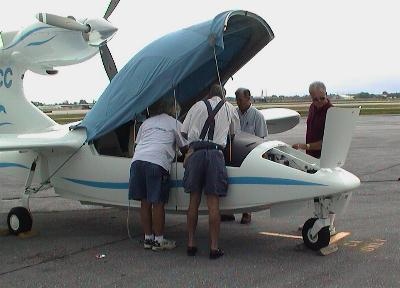 (In
the photo at the right, Kieth, Larry, Fred, and Ron discuss Keith's Seawind.) (In
the photo at the right, Kieth, Larry, Fred, and Ron discuss Keith's Seawind.)
The 2003 Seawind fly-in was organized and held by members of the
International Seawind Pilots Association and hosted by Mike Bowes in Sarasota
Florida.
For those of you who have ever had the privilege of attending a
Seawind fly in, you'll know that the written word falls far short of describing
these events. We started by meeting at an air-conditioned conference room at
Dolphin Aviation at 10:00 AM.
We held a typical hangar flying bull session among friends who
now have years of experience in common, even though some were attending a
Seawind fly-in for the first time. You simply had to be there to get the whole
of these discussions, but the gist of them is given below. Some of the topics of
special interest were the following:
 |
SNA Seawind kits, kit support, and building: Seawind kit production has been halted for the foreseeable
future. About
future kit support, the main point is that builders who need parts should
order them NOW. Future parts may only be available for the certificated
version. They will probably be more expensive, and may be somewhat
different. We can only speculate.
|
 |
SNA Certification thoughts and speculation: Paul
Furnee's letter (posted on the "News" page and the "Seawind
Piloting" page) was discussed at some length. The discussion by
experienced Seawind pilots was especially fascinating. Two overriding points
seemed to come out of this discussion: 1. Everyone
who is even the least bit familiar with the Seawind wants SNA to succeed. 2.
The consensus is that the published time table seems overly aggressive, but
we're all pulling for SNA. We collectively wish Dick and all at SNA the best
hopes for success.
|
 |
ISPA website format, content, and requests for
improvement: Since most of us bookmark the Hangar page and always go
directly there, it was requested that a note be placed in the
"Hangar" when the "News" page is updated. (Great idea. A
brief message will be posted when the "News" page is updated and
then removed later.)
|
 | Seawind resale value and liability considerations:
Since Seawind kit production has been halted, our
feeling is that their value will probably go up. There is some thought that
they may become highly sought after collector's items. In light of this, the
value of keeping a Seawind registry, and the actual number of existing kits
was discussed.  The latest number of Seawind kits is 169 (as published by SNA in the news
articles about Dean Rickerson's Seawind, see links page. Kit #170 has since
been sold to ISPA member Tom Thunnell, and is scheduled for delivery in mid
October 2003). The point was made
by many long-time builders and owners at the meeting that some of these kits
only consisted of the ailerons. For now, our only reference for registry information
is our members. Please review the registry often, be on the lookout for any
information about Seawinds, and (as Tom did here) send me any information you can add.
The latest number of Seawind kits is 169 (as published by SNA in the news
articles about Dean Rickerson's Seawind, see links page. Kit #170 has since
been sold to ISPA member Tom Thunnell, and is scheduled for delivery in mid
October 2003). The point was made
by many long-time builders and owners at the meeting that some of these kits
only consisted of the ailerons. For now, our only reference for registry information
is our members. Please review the registry often, be on the lookout for any
information about Seawinds, and (as Tom did here) send me any information you can add.
The necessity for cutting up your Seawind with a chainsaw rather than
selling it is was discussed at some length. ( Yes folks, two members in the
room knew of folks cutting up beautiful kit-built aircraft with chainsaws or
saws-alls and sold for parts. None that we know of was a Seawind though.)
Several interesting points came out of the discussion. No one we know is
going to cut up their Seawind, no matter what. Liability as a builder apparently
lasts 18 years. Since many of us spent our children's inheritance on our
Seawinds, we may as well hand them down and keep them in the family. On the
other hand, there are qualified and interested buyers out there. During
recent years several Seawinds have sold. It just takes the right buyer, and
we as the builder/seller need to choose carefully.
|
 | Piloting the Seawind: The cross section of our
members includes individuals from all occupations. Many are high time
pilots, however many are not. For everyone, but especially those of us who
are low time pilots, this discussion carried the day. Actual piloting
techniques were covered in some detail, and followed pretty closely with the
information presented on the "Seawind Piloting" page. 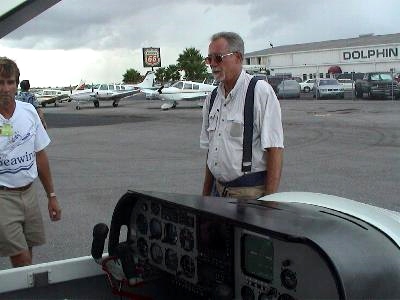 Two
of the pilots in the room, Larry and Keith, who are not pilots for a living,
discussed their experience with learning to fly the Seawind. This discussion
alone could fill pages, but in short, the summary goes something like this.
Low time, and general aviation pilots can learn to
safely fly a Seawind. Two
of the pilots in the room, Larry and Keith, who are not pilots for a living,
discussed their experience with learning to fly the Seawind. This discussion
alone could fill pages, but in short, the summary goes something like this.
Low time, and general aviation pilots can learn to
safely fly a Seawind.
(At right, Larry Sapp, rightfully proud, talks with Mike
about N514KT.)
In general, it will take at least 10 to 20 hours of dual with a
competent and experienced Seawind pilot, and 35 to 50 hours of
solo time in your Seawind before you will begin to feel comfortable. It
takes practice to master and coordinate pitch control. All the flight time
discussed here is land operations only. Water operation will require that a
person be fully proficient with all aspects of Seawind specific flight and
land operation before beginning water operations. The consensus from
those with experience was best summed up by Mike Bowes, "she's a lady,
you've got to treat her like one." This discussion is particularly
helpful to those
of us low time pilots who view piloting the Seawind with considerable angst, however I did
note that even the high time pilots in the room relished this discussion
(who doesn't love to hangar fly ahy?). Thank you for helping.
Oh yes, Mike told his story first hand about a rather unpleasant flight(?)
experience he once had. It is contained in the "Newsletter
Archives" on this site so I won't repeat it here. Mike did leave out my
favorite part though, about "the airplane was going down the runway
shedding parts like a turkey at a Thanksgiving Feast!" (you
just had to be there.)
|
 | Insurance for the seawind: A great discussion was
held about insurance. Here's the summary. None there had hull insurance.
Most seemed to have liability insurance, as it is required in order to store
your airplane on some airports, particularly in America.  Most
had Avemco liability insurance and the cost seemed to be between $1200 and
$2000 per year depending on Seawind specific flight hours. It was also
mentioned that the coverage was pretty anemic. As I recall, the coverage was
limited to $100,000 medical per person and $1MM per incident. Most
had Avemco liability insurance and the cost seemed to be between $1200 and
$2000 per year depending on Seawind specific flight hours. It was also
mentioned that the coverage was pretty anemic. As I recall, the coverage was
limited to $100,000 medical per person and $1MM per incident.
(Photo at left: Keith Walljasper and Ron Greely discuss
Keith's Seawind canopy system)
No one at the fly-in, and no one we knew of had hull insurance. Hull insurance seems unavailable and/or prohibitive at this time.
This topic still results in a lot of consternation
for many Seawind owners. The most we can do to improve the situation is to
improve the safety record while increasing the flight hours of the Seawind.
(Editor's note: my insurance consists of enlisting the help of Mike Bowes
and his staff, and also the experience from all of you. Can you think of a better
policy?)
Part of this discussion that was particularly interesting revolved around the fact
that just having insurance may encourage a law suit. If there is no
insurance, there's probably not as much potential for the suing party to
"hit-it-big."
The discussion about builder liability and insurance was wrapped up with the
following:
A truck driver amused himself by running over
lawyers as they walked down the side of the road. Every time he saw a lawyer
walking along the road, he would swerve to hit him. There would be a loud
"thud," and then he would swerve back on the road.
As the truck driver drove along one day,
he saw a priest hitchhiking; he pulled over and asked the priest,
"Where are you going, Father?" The priest said he was on his way
to his church up the road. "I'll give you a lift."
The priest climbed into the passenger seat
and the truck driver continued down the road. Suddenly, the truck driver saw
a lawyer walking down the road and instinctively swerved to hit him. At the
last minute, he remembered he had a priest in the truck and swerved back
onto the road. Even though he knew he missed the lawyer, he still heard a
loud "thud." Unsure of where the noise came from, he glanced in
his mirrors. When he didn't see anything, he turned to the priest and said,
"I'm sorry, Father. I almost hit a lawyer."
The priest replied, "That's okay, I
got him with the door."
(Apologies to our ISPA
members who are lawyers, we think you're alright.)
|
 |
Fuel system configuration. Mike finally talked briefly about
his fuel system, which includes slight modifications to the SNA configuration,
but has now been flight tested for many hours. Mike's system enables
selection of left, right, or both tanks the way most of us have become accustomed.
Mike's system uses the same SNA vent scheme, and arguably could be viewed as
a simplification to the original system. From an engineering perspective,
Mike's design is "elegant." (yes, that is a legitimate engineering
term) Later, at Mike's shop, he showed us the components of his system, and
a new pump/filter system that is being installed in Dick Wolf's Seawind. OK,
we have to state here for the record, "don't mess with the fuel system
(unless you damn well know what you're doing)." A page describing the
N369JB fuel system, including photos from the fly-in, and a sketch provided
by Tony Jurcan has been added to the "Builder Tips" pages in the
"Members Only" section of the site.


|
The group talked in the conference room from 10:00 AM until
about 1:30 PM. Following the discussion we went out on the ramp to look at Keith,
Larry, and Mike's planes before going to Mike's Shop. Nothing could have
prepared me for the delight in visiting Bowes Aviation. It's even better than
everyone says. As most of you know, Mike has Three Seawinds, a Lion Heart, and a
Giles aerobatic plane in his shop.
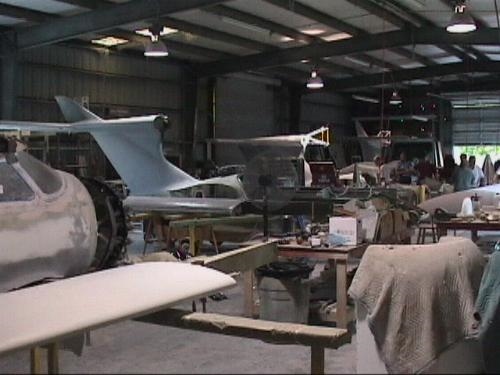 Of course, the discussions at the shop were going at several
different locations, so no one person was privy to everything. It
would be nice if each of you who were there would please write a brief paragraph
about things you may have listened in on, or that I failed to report, so they
can be posted here. Just write them in an email and send them to me. Of course, the discussions at the shop were going at several
different locations, so no one person was privy to everything. It
would be nice if each of you who were there would please write a brief paragraph
about things you may have listened in on, or that I failed to report, so they
can be posted here. Just write them in an email and send them to me.
At right: let's see, there is a Lion Heart, and one, two, three
...
Any
discussion about Mike's shop and his people simply has to start out with a
comment about the following: Mike and his people are true artisans and
professionals. Their work is superb. In addition,
they are just super nice people who are willing to share and help in any way
they can.
It is impossible to list everything I saw in the shop. Some of
the interesting items included the following:
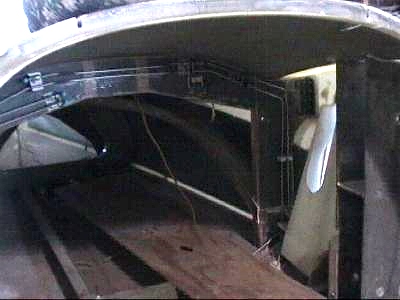 One of the Seawind owner/builders who's plane is in the shop is ISPA
member John Parks. I spent a lot of time looking at
John's stainless steel hydraulic line installation and talking with him
about it. John is using
stainless to avoid any possibility of corrosion. A side note, after a separate
discussion about the cabin heat system with John, he handed me a handful of SNA
cabin heat parts so that I can get started on building my own. (SNA does not
currently have any cabin heat options available for kits.) One of the Seawind owner/builders who's plane is in the shop is ISPA
member John Parks. I spent a lot of time looking at
John's stainless steel hydraulic line installation and talking with him
about it. John is using
stainless to avoid any possibility of corrosion. A side note, after a separate
discussion about the cabin heat system with John, he handed me a handful of SNA
cabin heat parts so that I can get started on building my own. (SNA does not
currently have any cabin heat options available for kits.)
John also mounted the aileron pulleys that are located behind the146 bulkhead in an interesting way. At Mike's
suggestion, he widened the 146 bulkhead below the aft floor so that the lower
aileron pulley could be mounted below (and clear of) the removal hole for the
landing gear leg pin. Time spent talking with someone like
John, who has experienced the building process is invaluable. John, like
everyone at the fly in, is knowledgeable, genuine, and helpful. Thank you John.
 Instrument
panels that come out of Mike's shop are stunning when seen up close. But the
reasons aren't all that obvious. Dick Wolf's control console and instrument
panel installation was at a point where everything could be inspected. Instrument
panels that come out of Mike's shop are stunning when seen up close. But the
reasons aren't all that obvious. Dick Wolf's control console and instrument
panel installation was at a point where everything could be inspected.
(The photo at the right shows Larry's panel)
I learned
that part of the reason these panels look so different, and so nice, is that
instead of canting them back at an angle, "Mike and the Mechanics"
position them straight up. This is the kind of thing you look at but don't see.
I have already cut my panel supports to the configuration shown in the builder
manual, so now I have to do some rework, and as you know, rework takes longer
than doing it right.
One other lesson I learned (and just-in-time for a change) is
that you don't want to position your mixer assembly and drill the associated
mounting holes in the bulkheads until you have the wings on and properly
position the flap drive bell cranks relative to the hull. Thank you Ed Lynch.

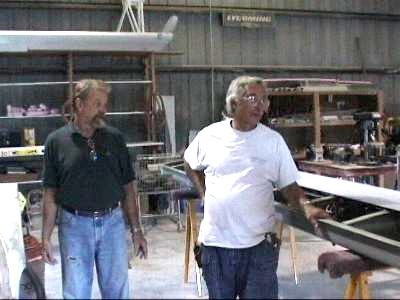
Chris and Keith
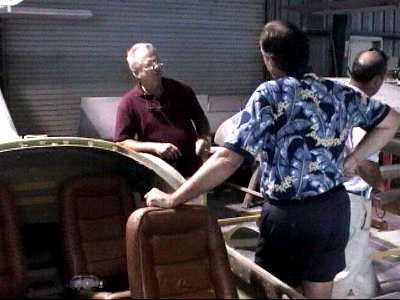
Ron Greely, Dick Wolf, and Fred Lohr
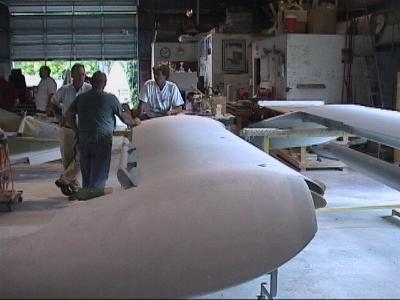
John Parks (back), Fred Lohr, Tom Saccio, Mike Bowes.
(These are Dick Wolf's finished wings.)
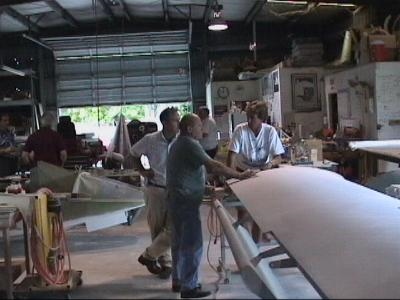
Dick Wolf and Ron Greely on left of picture, otherwise, same as above
(This page, added September 28, 2003,
has more to come.)
(All photos B. A. Carlson)
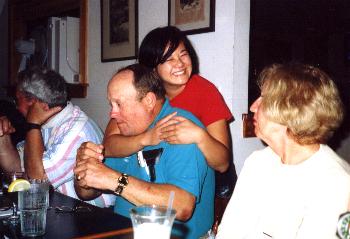
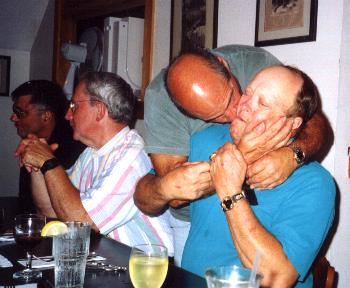
The two pictures above are from our 2002 Splash-in, but weren't received
until the 2003 fly-in. Everyone loves Art. No other caption necessary, except
that
Art probably didn't enjoy it as much as we did.
(Thank you Keith Walljasper for the Photos)
                   

|